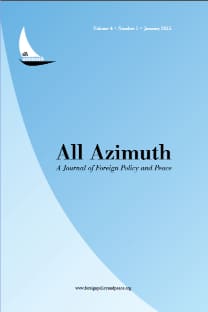A Dynamic Model of the Spread of Intrastate War
A Dynamic Model of the Spread of Intrastate War
___
- Akgul, Oner. “A Bibliographical Study on the Academic Research of Peace and Conflict in Turkey.” Paper presented at the 7th Eurasian Peace Science Meeting, İstanbul, 2018.
- Altmann, Michael. “Susceptible-Infected-Removed Epidemic Models with Dynamic Partnerships.” Journal of Mathematical Biology 33, no. 6 (1995): 661–75.
- Aydin,Mustafa, Fulya Hisaroglu, and Korhan Yazgan. “Türkiye’de uluslararası iliskiler akademisyenleri ve alana yönelik yaklaşımları üzerine bir inceleme: TRIP 2014 sonuçları.” Uluslararası İlişkiler 12, no. 48 (2016): 3–35.
- Barro, Robert J., and Xavier Sala-i Martin. “Converge.” Journal of Political Economy 100, no. 2 (1992): 223–51.
- Benson, Michelle, and Jacek Kugler. “Power Parity, Democracy and the Severity of Internal Violence.” Journal of Conflict Resolution 42, no. 2 (1998): 196–209.
- Bosker, Maarten, and Joppe de Ree. “Ethnicity and the Spread of Civil War.” Journal of Development Economics 108 (2014): 206–21.
- Braithwaite, Alex. “Location, Location, Location… Identifying Hot spots of International Conflict.” International Interactions 31, no. 3 (2007): 251–73.
- Braithwaite, Alex. “Resisting Infection: How State Capacity Conditions Conflict Contagion.” Journal of Peace Research 47, no. 3 (2010): 311–19.
- Brannan, James R., and William E. Boyce. Differential Equations: An Introduction to Modern Methods and Applications. 3rd ed. New York: Wiley, 2015.
- Buhaug, Halvard, and Kristian Skrede Gleditsch. “Contagion or Confusion? Why Conflicts Cluster in Space.” International Studies Quarterly 52, no. 2 (2008): 215–33.
- Cederman, Lars–Erik, Kristian Skrede Gleditsch, and Halvard Buhaug. Inequality, Grievances, and Civil War. New York: Cambridge University Press, 2013.
- Danneman, Nathan, and Emily Hencken Ritter. “Contagious Rebellion and Preemptive Repression.” Journal of Conflict Resolution 58, no. 2 (2014): 254–79.
- Fearon, James D. “Commitment Problems and the Spread of Ethnic Conflict.” In The International Spread of Ethnic Conflict: Fear, Diffusion, and Escalation, edited by David A. Lake and Donald S. Rothchild, 107–26. Princeton: Princeton University Press, 1998.
- Fearon, James D., and David D. Laitin. “Ethnicity, Insurgency and Civil War.” The American Political Science Review 97, no. 1 (2003): 75–90.
- Feenstra, Robert C., Robert Inklaar and Marcel P. Timmer. “The Next Generation of the Penn World Table.” American Economic Review 105, no. 10 (2015): 3150–82.
- Forsberg, Erika. “Diffusion in the Study of Civil Wars: A Cautionary Tale.” International Studies Review 16, no. 2 (2014): 188–98.
- Hegre, Havard. “The Duration and Termination of Civil War.” Journal of Peace Research 41, no. 3 (2004): 243–52.
- Kadera, Kelly M. “Transmission, Barriers, and Constraints: A Dynamic Model of the Spread of War.” Journal of Conflict Resolution 42, no. 3 (1998): 367–87.
- Kermack, William Ogilvy, and Anderson Gray McKendrick. “A Contribution to the Mathematical Theory of Epidemics.” Proceedings of the Royal Society A.: Mathematical, Physical and Engineering Sciences 115 no. 772 (1927): 700–21.
- Konaev, Margarita, and Kirstin J. H. Brathwaite. “Dangerous Neighborhoods: State Behavior and the Spread of Ethnic Conflict.” Conflict Management and Peace Science Forthcoming (2019): 1–22.
- Kugler, Jacek, and Ronald L. Tammen. The Performance of Nations. Boulder: Rowman & Littlefield Publishers, 2012.
- Kuran, Timur. “Ethnic Dissimilation and International Diffusion.” The International Spread of Ethnic Conflict: Fear, Diffusion, and Escalation, edited by David A. Lake and Donald S. Rothchild, 35–60. Princeton: Princeton University Press, 1998.
- Marshall, Monty G. Major Episodes of Political Violence: 1946-2016. Maryland: Center for Systemic Peace, 2017.
- Marshall, Monty G., Keith Jaggers and Ted R. Gurr. Polity IV Project: Political Regime Characteristics and Transitions, 1800-2016. Maryland: Center for Systemic Peace, 2017.
- Murdoch, James C., and Todd Sandler. “Economic Growth, Civil Wars, and Spatial Spillovers.” Journal of Conflict Resolution 46, no. 1 (2002): 91–110.
- Phillips, Brian J. “Civil War, Spillover, and Neighbors’ Military Spending.” Conflict Management and Peace Science 32, no. 4 (2015): 425–42.
- Rustad, Siri Aas, et al. “All Conflict is Local: Modeling Sub-National Variation in Civil Conflict Risk.” Conflict Management and Peace Science 28, no. 1 (2011): 15–40.
- Salehyan, Idean, and Kristian Skrede Gleditsch. “Refugees and the Spread of Civil War.” International Organization 60, no. 2 (2006): 335–66.
- The World Bank. World Development Indicators. 2018. Accessed May 20, 2018. http://data.worldbank.org/datacatalog/world-development-indicators.
- United Nations High Commissioner for Refugees. Population Statistics. n.d. Accessed May 20, 2018. http:// popstats.unhcr.org/en/overview.
- Weaver, Mary Anne. Pakistan: In the Shadow of Jihad and Afghanistan. New York: Farrar, Straus & Giroux, 2003.
- ISSN: 2146-7757
- Yayın Aralığı: 2
- Başlangıç: 2012
- Yayıncı: Dış Politika ve Barış Araştırmaları Merkezi, İhsan Doğramacı Barış Vakfı
Ideas and Interests: European Democracy Aid and the Democracy-Security Dilemma, 1990-2010
James M. SCOTT, Brandy Jolliff SCOTT
State Human Rights Performance and Recommendations under the Universal Periodic Review
A Dynamic Model of the Spread of Intrastate War
Ali Şevket OVALI, İlkim ÖZDİKMENLİ
